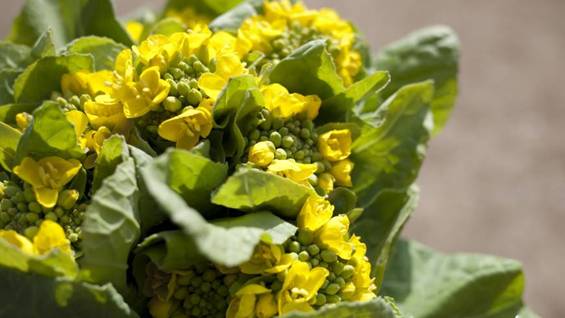Japanese people highly value the four seasons and it reflects greatly on our food culture. The seasonal foods play an important role in keeping Japanese people healthy.
・・・・・・・・・
Ready for spring’s fresh bounty
By MAKIKO ITOH

Vernal treasure: Closely related to broccoli, nanohana is best eaten in spring, when its buds are yellow-green. | MAKIKO ITOH
After an unusually cold winter, the sight of spring produce is particularly welcome, especially the bright yellow-green of nanohana. While plain-green nanohana is available almost year-round these days, it’s only in early spring when you see the ones picked from open fields that are covered in tiny just-emerging flower buds.
Nanohana is one of the oldest vegetables cultivated in Asia, including Japan. It’s closely related to the rapeseed or canola plant in Europe and the West, and also to broccoli, since all of these are members of the brassica family. While in the West rapeseed is usually only grown for its seeds, from which oil is extracted, in Japan the plant is used at various stages of growth. Each stage is given a different name, too: The young spring shoots are called nanohana, which literally means “flower of vegetable,” and the mature plant that’s used for oil as in the West is called aburana, which means “oil plant.” Rapeseed oil is called natane abura or “vegetable-seed oil” and has been used at least since the Edo Period (1603 to 1867).
While they are not as widely celebrated as sakura cherry trees, fields of yellow flowering nanohana are also a much-loved harbinger of spring, coming in between the ume (plum) blossoms that open in mid-February around the Tokyo area and the cherry blossoms that bloom in April. The word nanohana is a recognized seasonal word in haiku, signifying early spring. There’s also a well-known children’s song called “Oborozukiyo” (“Hazy Moonlit Spring Night”) that poetically describes a misty nanohana field in the early evening with a gentle spring breeze blowing over it.
Nanohana is a very versatile vegetable, high in vitamin C as well as other nutrients. It’s also a very frugal vegetable, since there’s nothing to throw away — the florets, stems and leaves are all edible. Unlike some other early spring vegetables, it has no bitterness or tannic quality, so it doesn’t need any special pretreatment. It both tastes and looks its best when the yellow flower buds are just emerging; once the flowers start to open the stems get a little tough, although you can get around this by cooking it just a bit longer.
As I’ve mentioned, nanohana is closely related to broccoli; I’ve seen varieties sold in the United States as broccolini or baby broccoli. The closest vegetable in the West might be broccoli rape, broccoli shoots that are popular in Italy. So you can use it in the same way you would use broccoli: simply steamed or boiled, stir-fried, in soups and so on. Nanohana is also excellent deep-fried with a tempura batter.
The most traditional way to eat nanohana in Japan, especially at this time of year, is as the side dish ohitashi. Simply cook the nanohana in boiling water until the stalks are just tender. Refresh under cold running water and drain well. Serve in a small bowl with some soy sauce or dashi stock mixed with soy sauce (3 tbsp of dashi to 1 tsp of soy sauce) and top with some katsuobushi (bonito flakes) or toasted sesame seeds. The bright-green florets with a sprinkling of yellow will add a colorful breath of spring to your dinner table.
The Japan Times:
http://www.japantimes.co.jp/life/2013/02/22/food/ready-for-springs-fresh-bounty/#.UUwEpldjh_N
